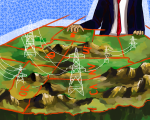In an era where certain federal authorities have been known to dismiss climate change as a Chinese hoax, Californian officials and legislators have made tireless promises to care for and protect the environment.
Progress on fixing power generation, however, has been more limited. After all, wind turbines don’t run on hot air.
In the state legislative session last year, two major pieces of climate legislation failed to pass due to last-minute opposition from various interest groups. One such bill, Senate Bill 100, would have required California to utilize entirely renewable energy sources by 2045. This ambitious goal was partially supported by Gov. Jerry Brown’s other failed initiative – a plan to integrate the power grids of several states into a single, huge, entity in western states.
The plan had its issues. Opponents argued that California would lose autonomy of its own grid, actually worsen carbon emissions and suppress the creation of jobs and newer power utilities.
With the gubernatorial election coming up in November, voters should require a plan from their candidates to resolve the problems exposed by these bills. For California to achieve its climate goals, the next governor needs to have the ability to navigate the complexities of energy policy. The grid integration plan can realistically help California’s environmental efforts, but only if it has support from the governor who knows what they’re doing moving forward.
The grid integration plan seeks to solve the issues with climate-friendly energy. California’s primary renewable energy sources – wind and solar power – are intermittent. Factors like weather conditions or time of day can affect the power output of such sources. Lack of output during peak times or unnecessary surges of power during periods of low demand can lead to headaches for the people at the California Independent System Operator, the organization responsible for balancing power load across the grid.
Excess power can cause structural damage to electric infrastructure. In the past, the state has even resorted to paying other states to take some power off the current grid.
A larger power grid would give grid operators more tools to work with. When power generation is down in one area, renewable energy from another area with excess could be brought in. In fact, one recent study published in the journal Nature Climate Change examined power grids across the nation and found grid integration would be an effective way to cut down on carbon emissions.
However, the older implementation of this idea put forward in the state Assembly had issues that lead to its failure.
Some critiques came from climate groups themselves. The Sierra Club, an environmental organization, stated that an earlier version of the plan involved partnering with PacifiCorp, an energy company outside the state, and could increase carbon emissions because the company uses coal to generate energy. Critics last year feared that grid integration would give fossil fuel plants, and sympathetic lawmakers in other states, greater ability to send non-renewable energy into California.
Newer versions of the initiative attempt to alleviate these concerns by restricting partnerships to more climate-friendly utility services, but state control of the grid remains an issue.
Energy unions have also opposed the plan, expressing fears that the integration would lead to a loss of jobs due to a probable decrease of renewable energy infrastructure within the state. Recent renditions of the plan have yet to address these concerns.
Additional complications could also arise from local variations in power generation.
Julien Gattaciecca, a project manager at the UCLA Luskin Center for Innovation, described California’s energy production as one set for highly localized, independent power generation. California uses community choice aggregators, entities that put governments in charge of energy procurement and allow cities or smaller regions greater autonomy over their power sources.
Existing rooftop solar systems would also have to be incorporated into the larger grid. These programs have often allowed communities the choice for more renewable energy options.
Some officials in charge of these networks indeed expressed concern last year over the potential for increased costs that grid integration may introduce.
State congressional members may be able to come up with solutions to some of these issues. They can’t do it alone, however. The upcoming governor should have plans in place to resolve issues posed by the integration plan. Integration as a whole is necessary for effective climate-friendly power generation.
After the primary election, it may appear that choices for such a candidate are slim. The gubernatorial election will host two candidates, one of whom is John Cox. Cox has expressed doubts that climate change is man-made, and courageously proposed that a warmer planet might even be a nice thing. His opponent, Lt. Gavin Newsom, may appear more acceptable by sheer contrast, given his willingness to address climate change.
However, Newsom should still come forward with a plan involving grid integration, and voters should still expect it of him. If climate change is to be on California’s legislative radar, grid integration will need to be a target. With the number of complications, challenges and compromises it poses, successfully implementing and maintaining an integrated power grid will require a stabilizing touch.
In the coming election cycle, more needs to be expected from candidates with regard to concrete climate change solutions. Though climate change itself is no hoax, voters need to believe that the state’s plans to combat it aren’t either.
